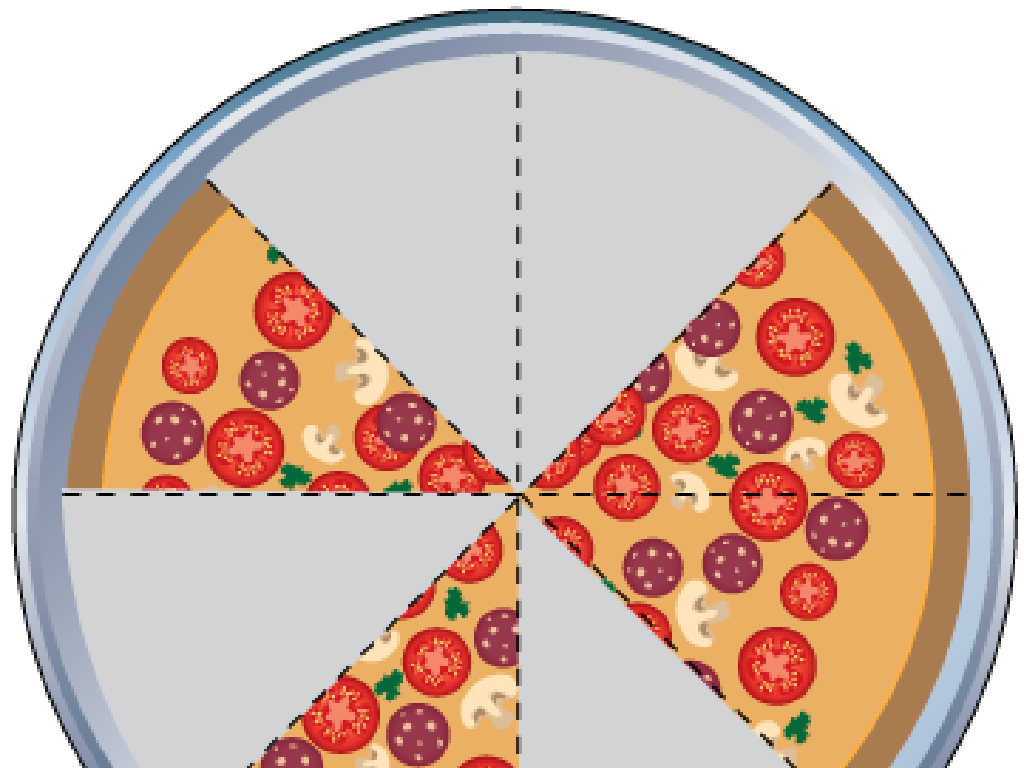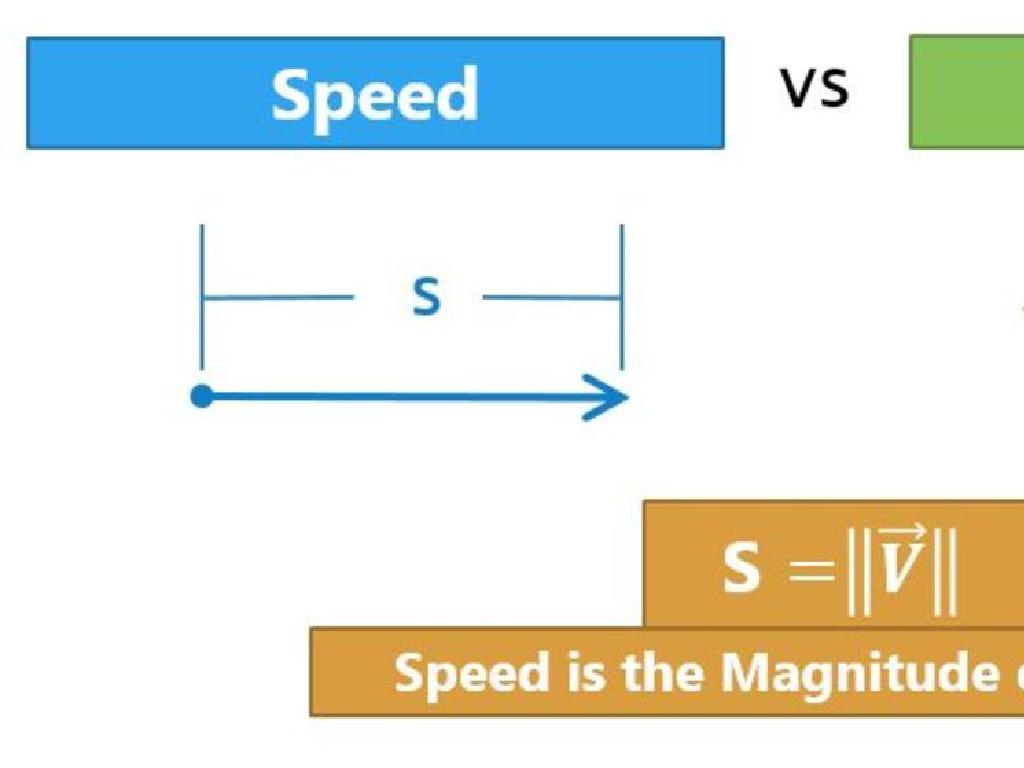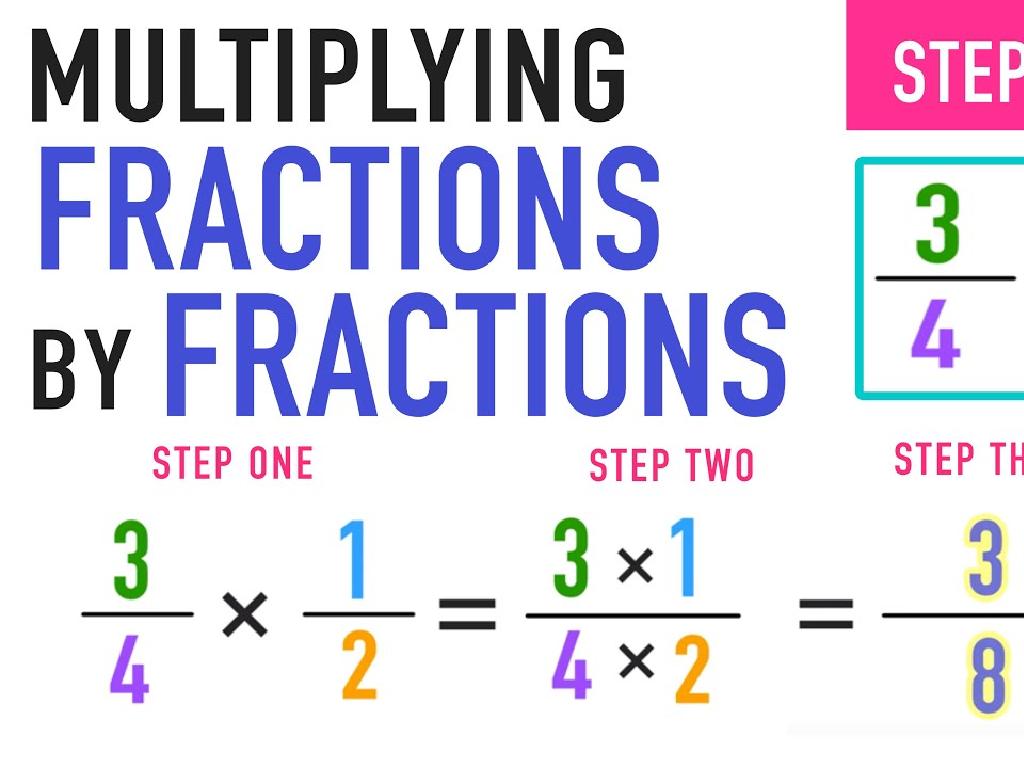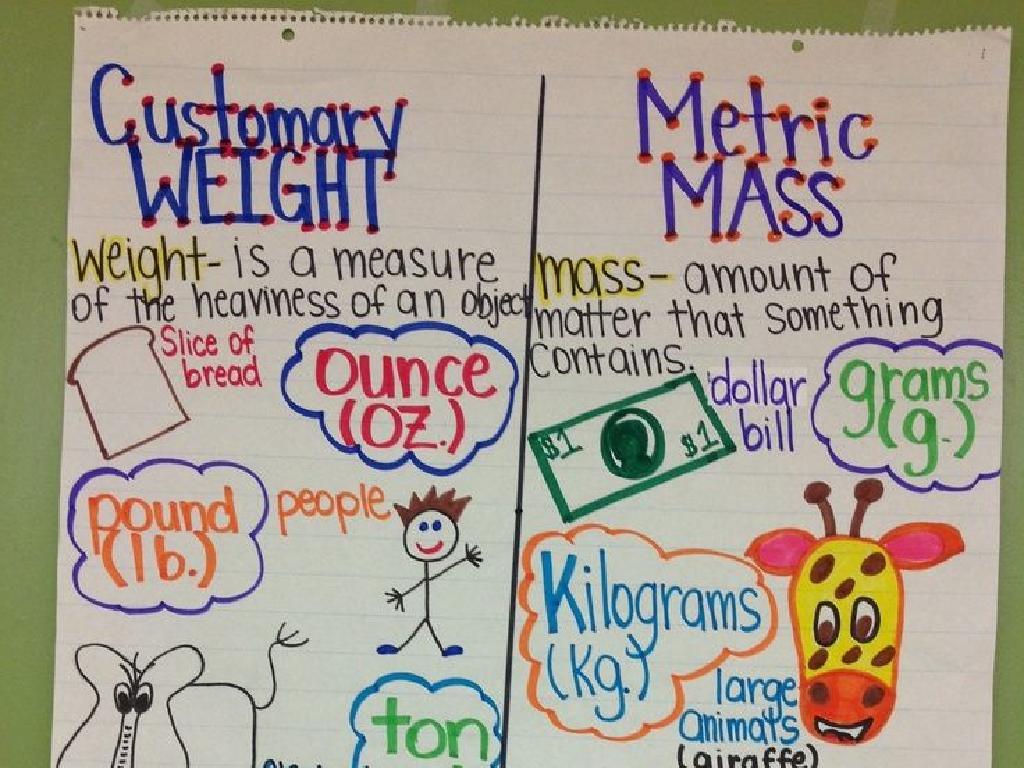Greatest And Least - Word Problems - Up To 100
Subject: Math
Grade: Second grade
Topic: Comparing And Ordering
Please LOG IN to download the presentation. Access is available to registered users only.
View More Content
Welcome to Comparing Numbers!
– Learn about Greatest and Least
– Comparing numbers in daily life
– Like when we compare scores or count money
– ‘Greatest’ vs ‘Least’ meaning
– Greatest: the biggest number, Least: the smallest number
– Class discussion on terms
|
This slide introduces the concept of comparing numbers, focusing on identifying the greatest and the least numbers within a set. Emphasize the practicality of this skill by relating it to everyday scenarios such as comparing scores in a game or counting money. Encourage students to participate by asking them to define ‘greatest’ and ‘least’ in their own words. This will help assess their prior knowledge and engage them in the learning process. Prepare to guide the discussion by providing examples and correcting misconceptions. For instance, if a student says ‘greatest’ means ‘best,’ clarify that in math, it refers to the largest number.
Understanding Comparisons in Math
– What does ‘comparing’ mean?
– Comparing is like a number game: which is bigger, smaller, or are they twins?
– Symbols for comparing numbers
– Greater than ( > ), less than ( 32 shows it’s you!
– Comparing numbers up to 100
– Let’s see which numbers win, lose, or tie when we play the comparison game!
|
This slide introduces the concept of comparison in mathematics to second-grade students. Begin by explaining that comparing is determining how numbers relate to each other in terms of size. Introduce the symbols for greater than, less than, and equal to, and ensure students understand what each symbol represents. Use relatable examples, such as comparing amounts of candies, to make the concept more tangible. Encourage students to practice by comparing different pairs of numbers up to 100, reinforcing the concept through repetition and engagement. The goal is for students to become comfortable with comparing numbers and using the correct symbols to represent their comparisons.
Understanding ‘Greatest’ and ‘Least’
– ‘Greatest’ means the biggest number
– ‘Least’ means the smallest number
– Use a number line to compare
– A number line shows numbers in order, which helps us see which is larger or smaller
– Let’s practice with examples!
– Example: Which is greatest: 23, 67, 45? Which is least: 18, 9, 27?
|
This slide introduces the concepts of ‘greatest’ and ‘least’ to second graders in a simple and relatable way. Emphasize that ‘greatest’ refers to the largest number in a set, while ‘least’ refers to the smallest. Introduce the number line as a visual aid to help students compare numbers and understand their relative sizes. During the class, use a number line drawn on the board to demonstrate how to find the greatest and least numbers. Encourage students to participate by picking numbers and placing them on the number line. For homework, assign a few simple word problems where they have to find the greatest and least numbers from a set.
Let’s Compare Numbers!
– Understanding greatest and least
– Comparing 23, 56, and 78
– Which number is the biggest?
– Finding the greatest number
– 78 is greater than 23 and 56
– Identifying the least number
– 23 is smaller than 56 and 78
|
This slide is aimed at helping second-grade students understand the concepts of greatest and least within the context of comparing numbers up to 100. Start by explaining that ‘greatest’ means the biggest number and ‘least’ means the smallest number. Use the example provided to show how to compare numbers by lining them up and looking at their value. 78 is the greatest because it is higher than both 23 and 56, while 23 is the least because it is lower than both 56 and 78. Encourage students to practice with different sets of numbers and to use this method to solve word problems involving comparison. This foundational skill will help them in various aspects of math, including addition, subtraction, and understanding number value.
Comparing Numbers with Word Problems
– Understanding comparison
– Real-life comparison examples
– How many apples? Who ran farther?
– Reading a word problem
– We’ll read a story problem as a class
– Finding greatest and least numbers
– Use clues to spot the biggest and smallest numbers
|
This slide introduces students to the concept of comparing numbers within the context of word problems, which is a practical application of math in everyday life. Start by explaining why comparison is important, using relatable examples such as comparing quantities of objects or distances. Then, move on to reading a word problem together as a class, guiding students to identify keywords and phrases that indicate comparison. Finally, demonstrate how to find the greatest and least numbers in a set by using these clues. Encourage students to think critically about the information given and to use comparison words like ‘more than’, ‘less than’, or ‘equal to’ when discussing their answers. For the class activity, prepare a few word problems where students have to find the greatest and least numbers, ensuring the numbers are within 100 to be age-appropriate.
Comparing Quantities: Emma’s Fruit Collection
– Emma’s apple count: 45
– Emma’s orange count: 32
– Emma’s banana count: 58
– Finding most & least fruits
– Compare numbers to determine which is greater and which is smaller.
|
This slide introduces a word problem designed to help second graders practice comparing numbers up to 100. Students will look at Emma’s collection of fruits and determine which type of fruit she has the most and the least of by comparing the quantities. The teacher should guide the students through the process of comparing numbers, using the example to show how to identify the greatest and the smallest numbers in a set. Encourage students to think about the problem and come up with the answer on their own before discussing it as a class. This exercise will help reinforce their understanding of comparing and ordering numbers.
Practice Time: Solving Word Problems
– Read the word problem carefully
– Find the greatest number in the story
– Which number is the biggest?
– Discover the least number in the story
– Which number is the smallest?
– Share your answers with the class
|
This slide is designed to engage students in an interactive activity where they apply their understanding of greatest and least numbers within the context of word problems. Provide a clear word problem for the students to solve, ensuring the numbers involved are within 100. Encourage them to read the problem multiple times to fully grasp the scenario. Guide them to identify the largest and smallest numbers mentioned in the problem. After they have solved the problem, create an opportunity for students to explain their thought process and answers to the class. This will help reinforce their learning and build confidence. Possible activities could include problems about comparing amounts of items in two scenarios, determining who has more or less of a certain object, or finding the highest and lowest temperatures in a week’s weather forecast.
Class Activity: Number Detective
– Become a Number Detective
– Find clues for greatest & least numbers
– Look for keywords like ‘most’, ‘least’, ‘greater than’, ‘fewer than’
– Pair up to solve word problems
– Share your detective findings
– Discuss how you solved the problems with your classmates
|
In this engaging class activity, students will work in pairs to enhance their problem-solving skills and understanding of numerical order. As Number Detectives, they will search for contextual clues within word problems to identify the greatest and least numbers up to 100. Encourage them to communicate and collaborate with their partners to solve the problems. Afterward, each pair will have the opportunity to present their findings to the class, fostering a collaborative learning environment. Possible activities include comparing quantities of items in a store, ranking animals by weight, or ordering numbers from least to greatest based on a story. The goal is to make learning about numbers fun and interactive.
Conclusion: Becoming Number Detectives
– Celebrating our detective work
– Reviewing our learning journey
Can you recall how to find the greatest and least numbers?
– Understanding the value of comparison
Comparing numbers helps us solve problems and make decisions.
– Applying our skills in real life
Think about how you can use this when shopping or organizing things.
|
As we wrap up today’s lesson on comparing and ordering numbers up to 100, take a moment to celebrate the students’ hard work. Encourage them to reflect on what they’ve learned about identifying the greatest and least numbers in word problems. Emphasize the practical applications of these skills in everyday life, such as making choices based on quantities or prices. Ask open-ended questions to facilitate a discussion and review the key concepts. This will help reinforce their understanding and ensure they can apply these skills outside of the classroom. Remember to praise their efforts and progress in becoming confident with numbers.
Homework Challenge: Number Detective
– Take home your Number Detective badge
– Solve greatest and least number problems
– Use clues in problems to compare numbers
– Find the greatest and least numbers up to 100
– Remember, greatest means the biggest number
– Review answers in the next class
– Get ready to discuss how you solved the problems
|
This homework activity is designed to reinforce the concepts of comparing and ordering numbers up to 100. By taking on the role of a ‘Number Detective’, students will be more engaged and view the homework as a fun challenge. Provide examples of word problems in class to ensure they understand how to extract the necessary information to compare numbers. Remind them to look for keywords like ‘greater than’, ‘less than’, or ‘most’ to determine the greatest and least numbers. Encourage them to check their work by comparing their answers with a partner during the review session tomorrow. This will not only help them correct any mistakes but also enhance their understanding through peer learning.






